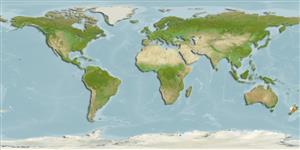Myxini (slijmprikken) (hagfishes) >
Myxiniformes (Hagfishes) >
Myxinidae (Hagfishes) > Eptatretinae
Etymology: Eptatretus: hepta (Gr.), seven; tretos (Gr.), perforated (i.e., with holes), referring to seven gill apertures on what would later be described as Homea banksii (=E. cirrhatus) [range within genus is 6-14 pairs of gill apertures]. (See ETYFish); cryptus: From kryptos (Gr.), hidden or secret, referring to its similar morphology to E. cirrhatus, with which it has been confused in the past. (See ETYFish).
Environment: milieu / climate zone / depth range / distribution range
Ecologie
marien bathydemersaal; diepte 96 - 922 m (Ref. 115309). Deep-water
Western Pacific: New Zealand.
Grootte / Gewicht / Leeftijd
Maturity: Lm ? range ? - ? cm
Max length : 93.1 cm TL mannelijk / geslacht onbekend; (Ref. 115309)
Korte beschrijving
Morfologie | Morfometrie
Dorsale stekels (totaal): 0; Dorsale zachte stralen (totaal): 0; Anale stekels 0; Anale zachte stralen: 0. Diagnosis: characterized by the combination of the following characters: 7 pairs of gill pouches, 3/3 multicusps, 12–15 prebranchial slime pores (modally 14), 78–86 total slime pores, slime pores without narrow white rim, preocular length 4.8–5.8% TL, and body colour brown to dark brown; differs from all other congeners except E. caribbeaus, E. menezesi, E. strahani, E. cirrhatus, and E. goliath by having 7 pairs of gill pouches and 3/3 multicusps; Eptatretus caribbeaus, E. menezesi, and E. strahani are not found in New Zealand; differs from E. caribbeaus by the number of anterior unicusps (10–11 versus 11–13), posterior unicusps (8–10 versus 10–11), and body colour (brown to dark brown versus light tan); differs from E. menezesi by the tail slime pores (11–14 versus 14–18), total slime pores (78–86 versus 86–94), and ventral finfold colour (brown versus whitish margin); it differs from E. strahani by having visible (versus absent) eyespots, rounded (versus slit-like) 1st few branchial apertures, vestigial (versus welldeveloped) ventral finfold (0.17–0.64%TL versus 1.12–1.16%TL), rounded (versus angled) ventral caudal fin profile, and shallower tail depth (8.1–10.6%TL versus 10.9–12.7%TL); differentiation from E. cirrhatus by the prebranchial slime pores (12–15, modally 14 versus 15– 18, modally 16), its more robust appearance (body depth 8.9–12.0% TL versus 5.9–11.2% TL, often <8.6% TL), and body colour (brown to dark brown versus dark brown to purple-brown); some, and often most, slime pores of E. cirrhatus have a narrow white rim, whereas slime pores in E. cryptus sp. nov. are the same colour as the rest of the body; care must be taken not to interpret residual slime or internal structure of the slime pore for the presence of a white rim; Eptatretus cryptus differs from E. goliath by the trunk slime pores (46–54 versus 56–60) and total slime pores (78–86 versus 89–95); the following character can also help in dissociating E. cryptus from E. goliath: preocular length (>4.8 versus 3.7–5.2% TL) and prebranchial length (>20.3 versus 18.3–20.9% TL) (Ref. 115309).
This species is more commonly found deeper than 500 m. Its biology is largely unknown because it has been misidentified as the common hagfish E. cirrhatus; its stable carbon and nitrogen isotope signature indicated that this species feeds at a high trophic level, 3 levels above primary producers (Ref. 115309).
Levenscyclus en paargedrag
Maturiteit | Voortplanting | Paaien | Eieren | Fecunditeit | Larven
Zintzen, V., C.D. Roberts, L. Shepherd, A.L. Stewart, C.D. Struther, M.J. Anderson, M. McVeagh, M. Noren and B. Fernholm, 2015. Review and phylogeny of the New Zealand hagfishes (Myxiniformes: Myxinidae), with description of three new species. Zool. J. Linnean Soc. 174:363-393. (Ref. 115309)
Status op de Rode Lijst van het IUCN (Ref. 130435)
Gevaar voor de mens
Harmless
Gebruik door de mens
Visserij:
Meer informatie
Lokale namenSynoniemenMetabolismePredatorenEcotoxicologieVoortplantingMaturiteitPaaienPaaiaggregatiesFecunditeitEierenOntwikkeling van de eieren
Leeftijd/GrootteGroeiLengte-gewichtLengte-lengteLengtefrequentiesMorfometrieMorfologieLarvenLarvale populatiedynamiekRekruteringAbundantieBRUVS
ReferentiesAquacultuurAquacultuurprofielKweeklijnenGeneticaElectrophoresesErfelijkheidZiektesVerwerkingNutrientsMassaconversie
Tools
Speciale rapporten
Download XML
Internetbronnen
Estimates based on models
Fylogenetische diversiteitsindex (Ref.
82804): PD
50 = 0.5000 [Uniqueness, from 0.5 = low to 2.0 = high].
Bayesian length-weight: a=0.00204 (0.00092 - 0.00452), b=2.93 (2.73 - 3.13), in cm total length, based on LWR estimates for this (Sub)family-body shape (Ref.
93245).
Trofisch niveau (Ref.
69278): 4.4 ±0.7 se; based on size and trophs of closest relatives
Fishing Vulnerability (Ref.
59153): High vulnerability (57 of 100).
